AudioCulture
The noisy library of New Zealand music
Te pātaka korihi o ngā puoro o Aotearoa
This Sporting Life
aka Alms For Children
Paul Fogarty (guitar), Ben Hayman (bass), Daron Johns (drums) and Gary “Rodent” Charlton (vocals) had been at the innovative edge of the early 1980s New Zealand indie boom for nearly two years by then.
The music bug bit Fogarty and Hayman in 1979 and 1980, having been early fans of The Buzzcocks and The Stranglers before moving on to Magazine, The Fall, Gang of Four, The Mekons and Joy Division.
Paul Fogarty and Ben Hayman, March 2015: “When it became apparent that you didn’t need to be a musical genius to get involved [in making music], we decided to start a band and give it a go. Chord books were bought and I bought a second hand Ibanez Les Paul copy. Ben decided to build his own fretless bass with metal neck.
“We started going out to see a lot of the local post-punk bands play. I remember catching The Gordon Bennetts play with Harry Ratbag on bass and doing a rather fine rendition of ‘Damaged Goods’.
“We got our friend from school, Adrian Leigh to 'sing/talk' and practised with a range of drummers in the garage that Ben cleaned for a job. It all sounded like Warsaw (early Joy Division). Three covers were mauled (‘Neat, Neat, Neat’, ‘12XU’ and ‘ESP’ – all short and simple songs) then Adrian decided that singing wasn’t for him.
“We placed ads in RipItUp and on message boards in music stores and at the university looking for a new vocalist. Gary Charlton [Rodent] auditioned. He turned up in a neat old Vauxhall, compete with Doc Martens boots, looking the part, and he could sing a bit.
“Gary had been around in the punk and boot boy scene in Auckland (he roadied for The Terrorways) and knew a lot of people and although by now punk had moved on, I remember thinking his connections could be good to get us some gigs.
“Apart from that he was a top bloke and had a big personality and could front the band with Ben and I concentrating on playing and learning our instruments. We had enough on our hands. We named the band Arms For Children after seeing medicine bottle warnings of things being Harmful to Children.”
“We played church hall dance gigs with bands, including Rebel Truce, The Screaming Meemees, The Killjoys, The Ainsworths and other North Shore bands. We had different musical styles – ska, punk, 60s influenced – but all got on well. It seemed like there was always a gig or a party on somewhere to go and play. We were still missing a ‘proper drummer’ though.
“Daron Johns (eventual AFC drummer) was living in Christchurch. He was friends with John Halverson of The Gordons, and Daron became a massive Gordons fan. One of the reasons he came to Auckland was to follow them on their tour up North.
“Gary (Rodent) worked at the Travelodge in town as a bellboy. A surprising number of band people worked there. Tony Drumm from the Meemees, Dean Martelli from The Terrorways and Rebel Truce, and Adam Holt to name a few. The manager would famously ask prospective employees if they were there for a job or to form a band. Daron’s sister worked there as well and through her, we were introduced to Daron as our prospective full time drummer.
“We auditioned Daron and took away his cymbals (well, not all of them) and it all just clicked into place.”
Arms For Children’s first outing after that was a three-night stint with The Screaming Meemees and a collection of groups at XS Café.
Arms For Children’s first outing after that was a three-night stint with The Screaming Meemees and a collection of groups at XS Café. At each soundcheck they wrote a new song and played it that night until they had eight accumulated.
Paul Fogarty: “Chris Knox was at the gig and came up to Gary, who he knew, after we had played and remarked, ‘Wow, that was great, I never thought you would be in a band like that’. We took it as a compliment!”
New equipment was bought. An Aria Pro II bass for Ben and a Musicman Stingray II guitar for Paul, which helped create their signature sound. Simon Shanahan, ex Frank Xerox and The Duplicators (and a flatmate of Gary’s) joined as the fifth member to do sound. The group’s name was changed as well to Alms For Children, alms as in charity.
Alms For Children were out and about on Auckland stages in April 1981, paired up with the similarly exciting Herco Pilots at all-ages post-punk incubator XS Café in Airedale Street.
The Queen City quartet spent two nights at St Thomas Hall in Kohimarama on 8 and 9 April with North Shore acts The Screaming Meemees, The Ainsworths and Blam Blam Blam.
At the end of the month Alms For Children joined an impressive line-up for the May 24, 1981 Battle of The Bands final at Mainstreet alongside the Prime Movers, The Clean, The Androidss, Famous Five, Instigators and Youth For A Price. All of whom would record their own punk version of Warhol’s fifteen minutes of fame – the great single or song. Some would record a solitary track (Famous Five, Youth For A Price), some a handful like Alms For Children and The Androidss. The Clean and Blam Blam Blam managed a whole lot more. Such was the strength of post-punk music in Auckland that year.
Of Alms For Children’s performance, RipItUp’s Mark Phillips wrote, “[They] are young, sharp and oozing with confidence. They ran through an all-original set that included their single to be ‘Danny Boy’. A band to watch.”
The kinetic quartet teamed up with the best of the city’s new groups for live shows, as they did with the moody propulsive Danse Macabre at The Reverb Room for three days at the end of May. In June they took the stage with Famous Five in the short-lived Basement venue in Fanshawe Street, before stepping out with the like-minded Herco Pilots and Danse Macabre at the Rumba Bar for three nights, and polishing the month off with Blam Blam Blam at the same venue.
Fogarty and Hayman: “As we gigged more, we spent more time hanging out with Harry Ratbag and Herco Pilots. They had just produced their first EP and Harry suggested we do likewise on his newly formed REM records. We saved up and did a dawn to dusk recording session at Harlequin studios and recorded ‘Danny Boy’, ‘Mother’ and ‘Failsafe’ (with Harry Ratbag in attendance with Steinies on tap).”
“Harlequin at the time was a high tech studio and Steve Kennedy was the engineer who guided us through it all and did a great job in capturing our sound. Steve was engineering a lot of emerging bands and did a lot of work for Propeller.
Alms For Children celebrated their first and only single, Alms Not Arms, slipping into the No.48 spot on the Singles Chart for one week.
Then it was back to the Reverb Room with The Screaming Meemees in early July. They joined The Furys there mid-month and Herco Pilots at Rumba Bar, then Vivid Militia at the Station Hotel, indicating the breadth of venues now available in the city. Pairing with Vivid Militia again in August at Reverb Room, Alms For Children celebrated their first and only single, Alms Not Arms, slipping into the No.48 spot on the Singles Chart for one week.
Sheathed in a printed-over long white envelope, the EP sold for three dollars and sported two standout songs, the cheekily titled ‘Danny Boy’ with its sarky clipped Rodent vocal propelled by a choppy, syncopated Fall-like rhythm, and the similar sounding ‘Failsafe’.
Paul Fogarty: “Ben worked in a stationery warehouse, so we got envelopes for sleeves and did our own covers and labels and released it as the second REM records product after the Herco’s first release. ‘Danny Boy’ as a track got to No.48 in the charts for some reason and the music show Droppa Kulcha did a very clichéd video of us playing ‘Mother’ off that EP in the rain beside the wall at Zwines.”
Six days after the record’s chart entrance, Alms For Children joined Danse Macabre and Missing Tremble at the Rumba Bar for three nights before heading out west to Massey Community Hall for a night with The Prime Movers and Famous Five.
They chased that with three well-received dates at Christchurch’s DB Gladstone in early September with Herco Pilots and Danse Macabre.
Fogarty and Hayman: “Now firmly in the REM stable, we played a lot with Herco’s and Danse Macabre, who were fronted by Harry’s brother Nigel. We toured to Christchurch with them to play the infamous DB Gladstone.
“We were playing there for three nights and The Gordons, one of our favourite bands at the time, were playing the two nights before us. We had an ‘interesting’ trip down in that Barry Jenkin, 1ZM DJ and promoter of indie music had volunteered to fly some of us who had jobs down in a Cessna (turns out he was a pilot – who knew?).
“That was a mistake, as it turned out. The Cessna struggled into strong winds across Cook Strait and for quite a while disappeared off the radar from Wellington Airport. Those of us that drove the van with the gear down got to Christchurch to wait many long hours for news as to whether the plane had crashed or not. They arrived in the kind of haze that often accompanied that particular set of people and thought the whole thing was hilarious.
“We did our gigs that weekend at the Gladstone and stayed in their band house. On Friday night, a big party happened nearby to which we drove in our van. We had a photographer with us on tour (bit of a luxury but Danse Macabre were on a publicity buildup for their EP) and all his gear, plus our guitars got packed into the van. We went to leave and found our van had been broken into and everything nicked from it.
“The following day we wondered how we would play as our guitars were gone. We had amps and a drum kit. The Gordons offered us their gear so we started to sound check with their guitars. Barry Jenkin called a mate at a local radio station and got him to talk about our bad luck and say we wanted our gear back.
“The Gordons and our drummer Daron spread the word via the local fan base and a local skinhead group named Ayrian Army. Many of the ‘Army’ were Māori and brandishing swastika tattoos. It was close to gig time when we got news that the radio station had a tipoff that a car in a carpark nearby would be found to contain our gear. I'm not sure if it was The Gordons, Barry or the Ayrian’s, but it worked.”
Back in Auckland, Alms For Children stepped up to Mainstreet with The Screaming Meemees and new ska group Blue Asthmatics. The Clean were back in town by then. They tapped Alms For Children for two nights at the Rumba Bar, before the Aucklanders found more musically out-there company with Smelly Feet and A Second Nose at University of Auckland on September 25.
The final bell was tolling for Alms For Children on October 2 at Carrington Tech [now Unitec] with The Prime Movers and Missing Tremble. Just seven days later they played their last show with Famous Five and The Prime Movers at Massey Community Hall.
A young Garth C (Garth Cartwright) caught them that night and wrote it up in In Touch. “Watching Alms For Children progress over the months, they’ve developed an aggressive brand of music that’s propelled by a raw core of loud bass and drums while layered over by a screeching, jangly guitar and trebly vocals. All their songs pack a distinction and energy that provide a raw dance music: the single doesn’t do them justice.”
Along the way, Alms For Children had gathered up some fine performances and enduring experiences. Daron Johns: “I have memories of AFC playing at someone’s 21st party on the North Shore with super high society waiters everywhere and a heart shaped swimming pool.
“Then months later playing at some dingy church hall with boot boys everywhere. Chris Knox was MC and in his prime. He must have found a bag of pig’s eyeballs! Next thing I recall him wearing a chain of them around his head, and also trying not to stand on any on the stage. SICK! The sound felt like it was disappearing down a big dark hole at the back of the hall.”
Show Me To The Bellrope
Gary Rodent and Daron Johns left the group (Johns returned to Christchurch) leaving Ben Hayman and Paul Fogarty to carry on with new drummer Phil Jackson (The Ainsworths) as This Sporting Life. Rodent soon returned.
Fogarty and Hayman: “We shamelessly lifted the This Sporting Life name from a Mekons song as opposed to the Rob Storey book or the film of the same name. TSL took over the Rumba Bar for a weekend and screened Invasion of the Daleks and The Incredible Melting Man whilst we played the new songs we'd just assembled to launch the new/old band. All this was done for the princely sum of 50 cents entry fee! The gig was well attended and went down well.”
When Phil Jackson found God soon after, Daron Johns returned to the drumstool. From February through April 1982, This Sporting Life’s unholy racket possessed the Rumba Bar and Reverb Room with help from Danse Macabre and New Plymouth post-punks Nocturnal Projections.
This Sporting Life made it onto film as part of a project that captured The Chills, Tall Dwarfs (incognito) and The Clean at the Rumba Bar.
Early May, the boys were unsuccessful again at Battle of The Bands at Mainstreet. Later that month on May 15 This Sporting Life made it onto film as part of a project that captured The Chills, Tall Dwarfs (incognito) and The Clean at the Rumba Bar. The clip that survives shows a young, fresh-faced This Sporting Life (sleeveless cardies included) ratcheting out a fine version of the twin bass ‘Point To Point’, a song that would only ever appear on the 1986 Failsafe Records tape Biding My Time .
Then it was back to the Rumba Bar for nights and afternoons with Nocturnal Projections, The Chills and Fishschool, and onto the Reverb Room with Nocturnal Projections, all in June. Gone were the days of playing with the straighter sounding products of Auckland’s post-punk boom. This Sporting Life’s company on stage would now more often than not have a twist in their tail.
You got the feeling that the weirder end of the first post-punk era had finally caught up with the Auckland quartet when they shared a bill with Coalition, The Jellymen, Nocturnal Projections and Fishschool at St Benedict’s Hall. The odd afternoon at the Rumba Bar filled out the month.
The punk and immediate post-punk era in New Zealand is notable for how few of the best groups made it over from Great Britain. We heard plenty of the music on Barry Jenkin’s fascinating 1ZM radio show and imported and local records filled out more of the picture, but the actual bands live were thin on the ground. No wonder the buzz around The Fall’s August 1982 visit to Christchurch, Wellington and Auckland was near deafening.
The Fall were already popular in New Zealand to a degree that no other country equalled. Their records were available on import, but more importantly Gap Records out of Australia had a distribution agreement for The Fall with major label EMI Records, which extended to NZ as well (another group so blessed was Young Marble Giants).
Even so, The Fall hitting No.28 in the single charts in early August 1981 with ‘Totally Wired’ must have been a shock. It didn’t chart in the UK but the single spent six weeks in the chart here. In August 1982 the followup single ‘Lie Dream Of A Casino Soul’ peaked at no. 17 during a four-week chart stay.
Hex Enduction Hour did even better in the album chart that month, climbing to No.11 and staying for four weeks. Grotesque had already nudged into the album chart in August 1981, peaking at No.38. Yep, The Fall definitely had a popular following in New Zealand. Their impact on the nation’s left field groups was widespread.
It wasn’t surprising then that it was our most Fallish sounding band This Sporting Life along with The Clean who fronted up before the mad Mancs first shows at University of Canterbury and Christchurch Town Hall in mid-August. (This Sporting Life had already headed south for dates with The Stones at the DB Gladstone, Doug Hood was involved with promoting The Fall tour.)
They returned to Auckland with The Fall and played on one of their two Mainstreet nights. There was little interaction with the visitors, although The Fall’s guitarist Marc Riley suggested that Paul Fogarty take his amp down to the nearest quarry and blow it up. Riley then sold the TSL guitarist a green Burns Mirage guitar. By then TSL were regularly playing two songs with two basses and without a six string guitar. Ben and Paul would swap guitar and bass duties on various songs.
The first part of that anecdote came courtesy of Michael Higgins in RipItUp who collared TSL for a full feature.
In it This Sporting Life noted a shortage of venues in Auckland (“There’s only one we can play now and you can’t hold dances coz people come along and fuck them up.”) and the city’s good bands as Coalition, Fishschool, Nocturnal Projections and The Bombers. They felt that Christchurch audiences had been lukewarm compared to the reception Alms For Children received, something to do with the former having a single out.
Bad vibes were cast on Auckland’s emerging new dance club scene, although Gary Rodent saw its point. Watch this space.
Back in Auckland, This Sporting Life slipped back into old habits with The Prime Movers and The Screaming Meemees at Mainstreet in September, before returning in early October with them and Nocturnal Projections and Eight Living Legs. Two nights at the Windsor Castle followed.
Their album Show Me To The Bellrope came out in an eye-catching green and orange cover by Chris Williams.
November 1982 was a memorable month for This Sporting Life. Their album Show Me To The Bellrope came out in an eye-catching green and orange cover by Chris Williams (Herco Pilots and Coalition) with a twisted graphic The Fall would have been proud of. Two angry angular rockers stood out – ‘Total Loss’ and ‘Time’.
This Sporting Life started recording the album as far back as late 1981. “We headed into The Lab studio that was in the space that had been Squeeze nightclub. Harry from Herco’s introduced us to Studio 132 and we did some more recording there. This was a more lo-fi approach, which we were keen to explore. Doug Hood and Simon Shanahan took control of the engineering side.”
One song, ‘W.M.T’ (Wasting My Time) had been recorded by AFC in late 1981. The cost all up was $500, the same as Alms For Children’s three-song single.
“We had a good deal of studio time compared to our dusk till dawn sessions at Harlequin and therefore time for a little experimentation. It received good critical acclaim from memory and had a classic launch poster courtesy of Chris Knox.”
What came next was not so enjoyable. After a Windsor Castle performance on November 27 by Nocturnal Projections, Fishschool, This Sporting Life and Fetus Productions, the heavy handed Team Policing Unit, who had cast an intolerant pall over the Auckland music scene for years, snagged Gary Rodent, Chris Knox and Fishschool’s Chris Plummer outside the venue for offensive language, after they objected to police treatment of punters. All pleaded Not Guilty in court.
The group remained busy. A new record was recorded at Progressive Studios with Doug Hood and Terry King in late 1982.
This Sporting Life was soon playing again at University of Auckland café with The Stones and Active Eye in mid-December, but it was time to get out of town for a while. They saw 1983 in at the Army Hall in New Plymouth with some the best of the country’s post-punk groups.
Marshalled by Doug Hood and Brian Wafer, The Stones, First Fifteen, Unrestful Movements, Nocturnal Projections, Tall Dwarfs, Final Solution, Fetus Productions and This Sporting Life drew over 1,000 fans to the Army Hall on New Year’s Eve. A second show followed two days later at New Plymouth’s Bowl of Brooklands.
This Sporting Life found a new playmate in early 1983 in Children’s Hour, doubling with them at the Rumba Bar in mid-January. They returned again to the venue in early April but after that live shows were scarce.
TSL joined a whole swag of diverse groups at the Rumba Bar’s closing show, which was captured for Flying Nun Records’ The Last Rumba live album on June 6, 1983. Appearing alongside Children’s Hour, Phantom Forth, The Stones, Tall Dwarfs, Kevin Hawkins, The Exploding Budgies, Eight Living Legs, Flak, Heptocrats, Lesser Specked Gottliebs and The Gramme, This Sporting Life contributed ‘Wriggle Around’ to the resulting album.
While not yet finished, This Sporting Life was running out of puff. They chased The Last Rumba recording party with a night at Mainstreet with The Stones, Skeptics and Children’s Hour on June 15.
When In Limbo arrived in early 1984, having been lost for over a year amid the clutter of Chris Knox’s living room, it sported four new songs (‘Paper Chase’, ‘Difference’, ‘Too Proud’, ‘Patience’) and received indifferent reviews.
“The four songs here range from spritely and cheeky (‘Difference’) to hackneyed (‘Too Proud’), but it couldn’t be described as inspired, Ok?” RipItUp fudged. This Sporting Life was happy with the recording, which was a conscious attempt to make the sound “poppier.”
Remember the comment from Gary Rodent (Charlton) about dance clubs from the previous year? Well, he was serious. In August 1983, Rodent and DJ Mark Phillips opened Quay’s nightspot on Quay Street, where you could dance until 3am. With This Sporting Life stepping out at Mainstreet that month with The Screaming Meemees and Phantom Forth, it must have seemed like a double life.
When SPAM (Society For Promotion of Alternatives in Music) opened a new all-ages venue at 126 Symonds Street, This Sporting Life were still hanging on in there, but only just. The two nighter on November 18-19 with Phantom Forth, Marie & the Atom and The Stridulators was the pioneer post-punk group’s last.
“Due to a variety of reasons mainly evolving around growing up and not knowing what we wanted to do next, we decided to call it a day. I don’t think the violence in the music scene helped. Amongst all the good, we had seen a lot of bad. Venues were closing (XS, Rumba Bar, Station Hotel) and nightclubs were on the increase.
“For our last gig at SPAM, we resurrected a compilation of songs from AFC and TSL. Playing the old AFC songs was like returning to a comfortable place and maybe one we should have or could have built on.”
In July 2018 Failsafe Records issued a compilation of the band's work.
-
*All quotes are from both Paul Fogarty and Ben Hayman unless otherwise indicated
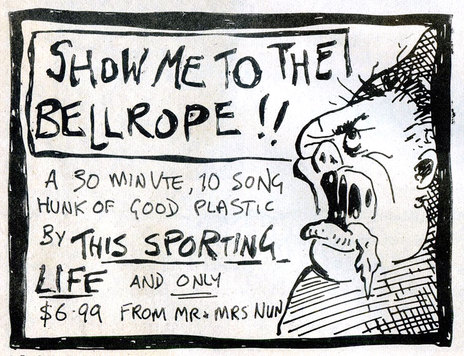
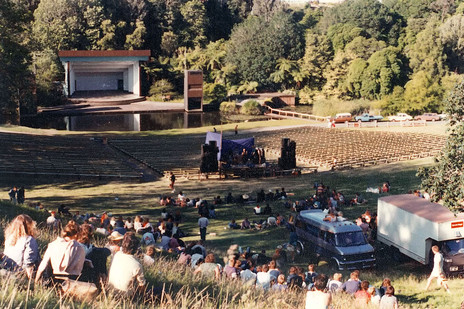
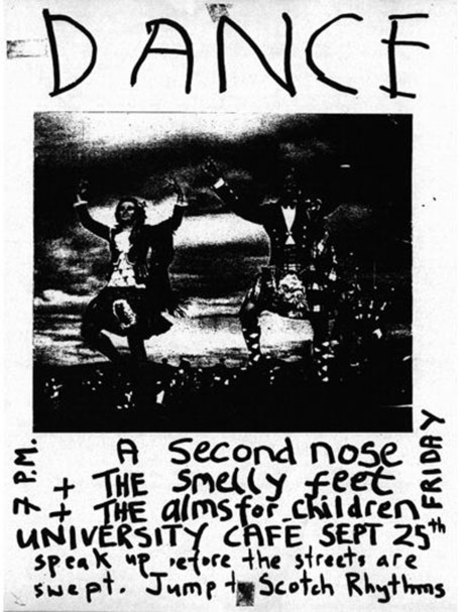
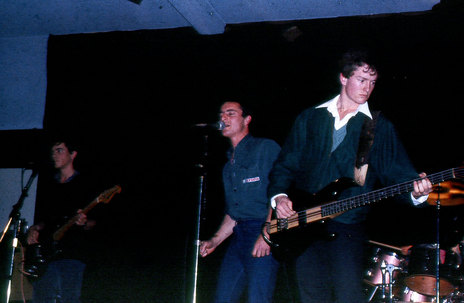
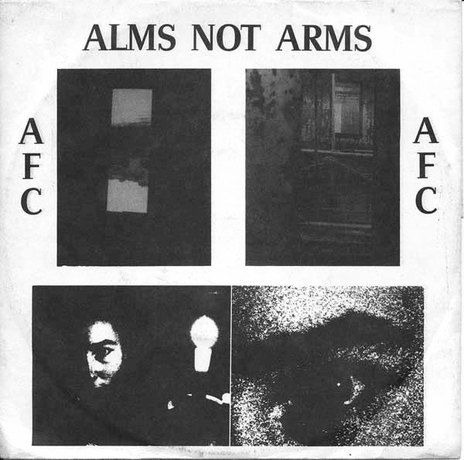
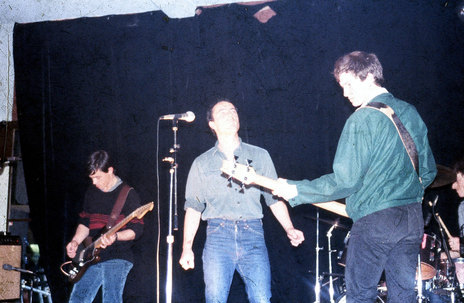
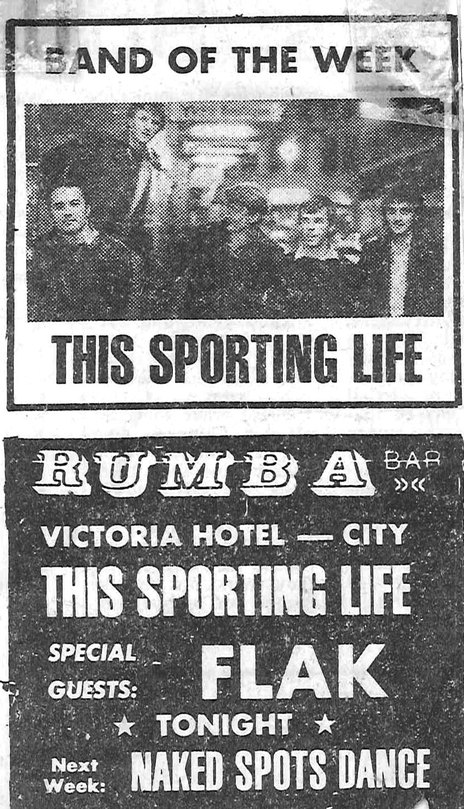
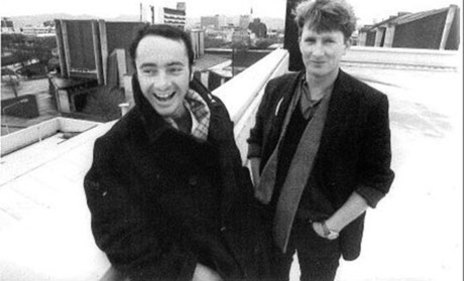
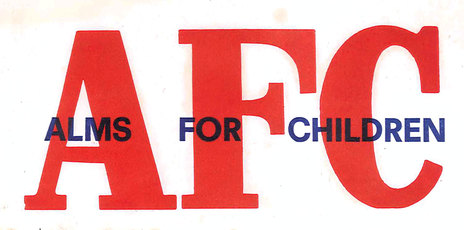
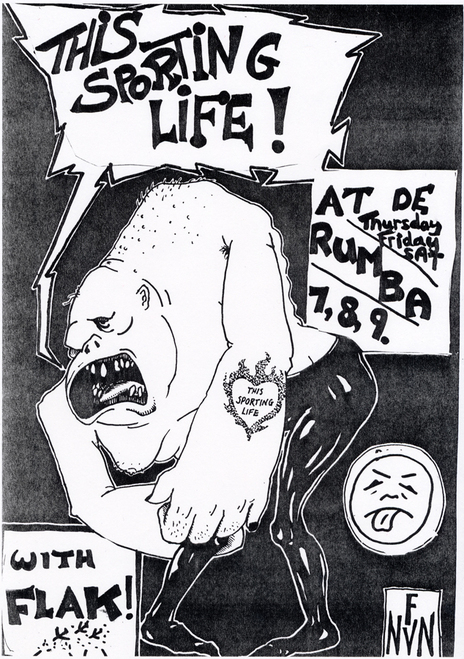
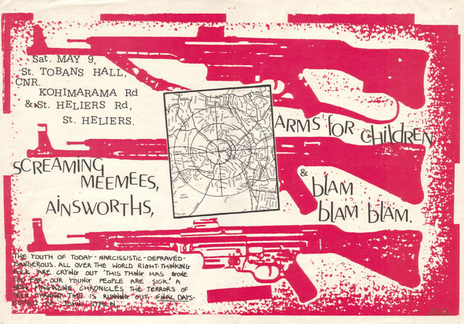
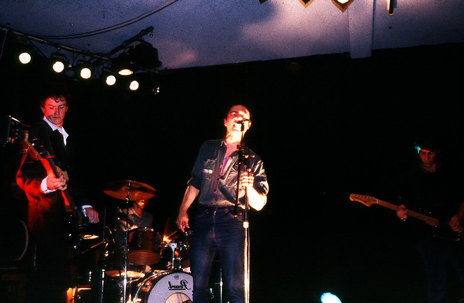
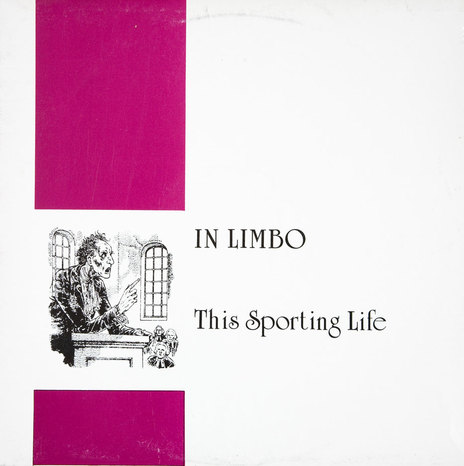
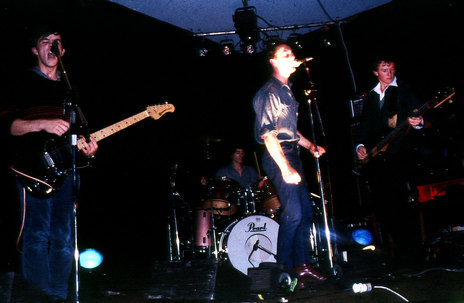
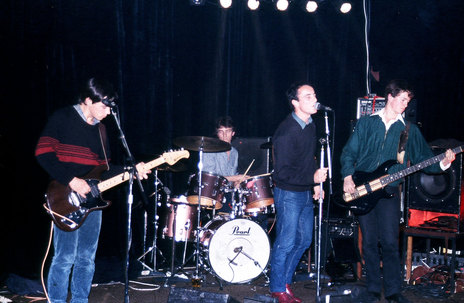
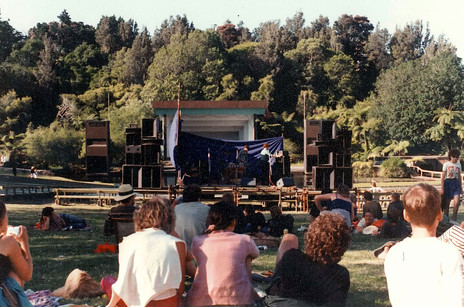
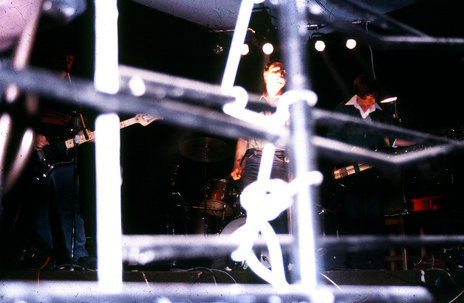
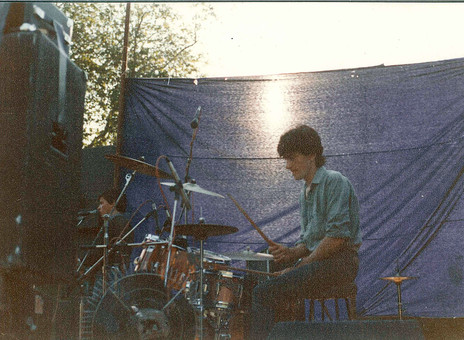
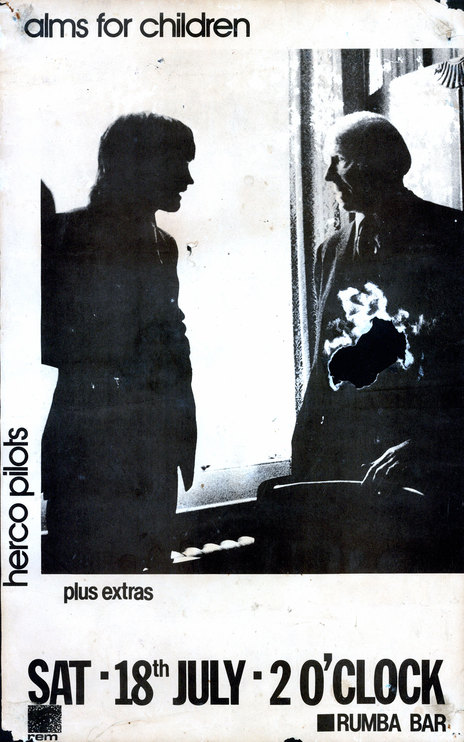
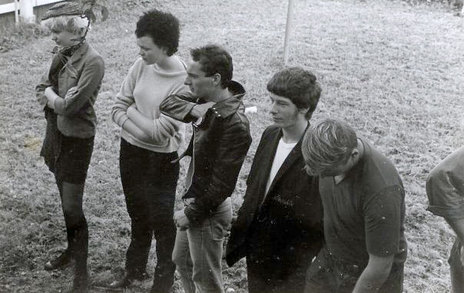
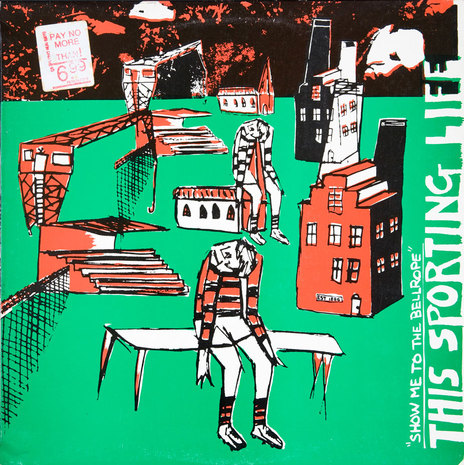
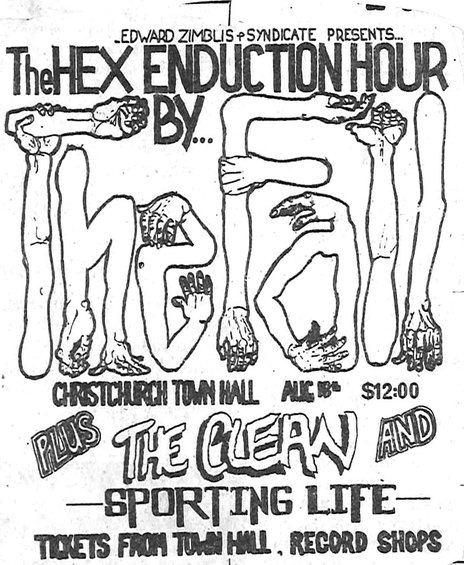
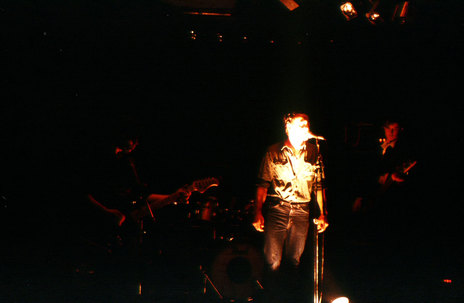
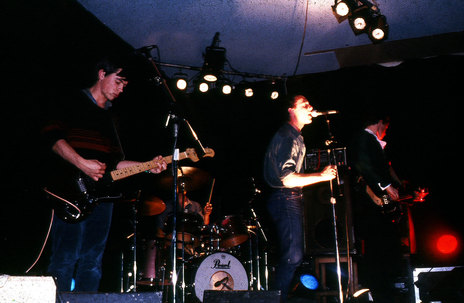
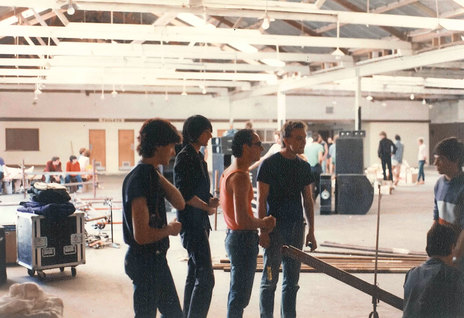
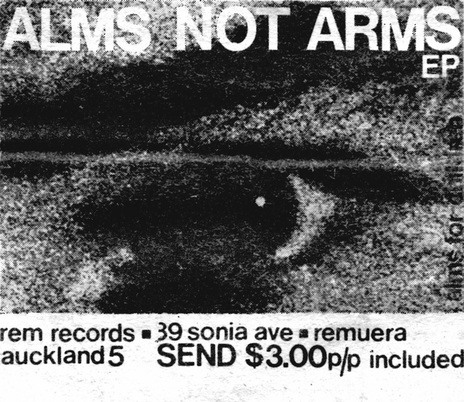
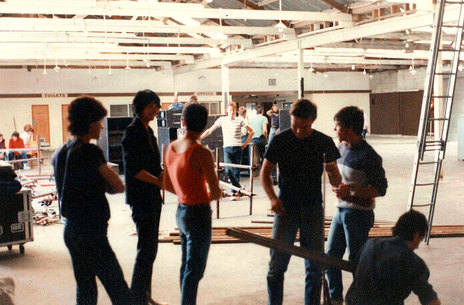
Paul Fogarty - guitar
Ben Hayman - bass
Daron Johns - drums
Gary Charlton - vocals
Phil Jackson - drums
Visit our sister site
NZ On ScreenMade with funding from
NZ On Air
